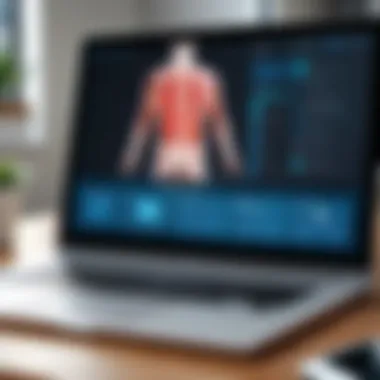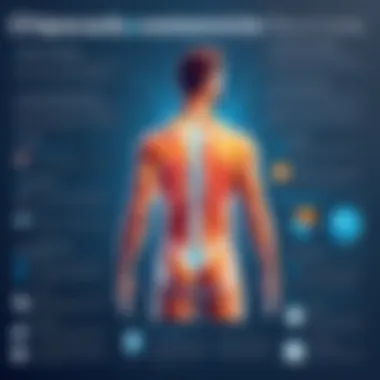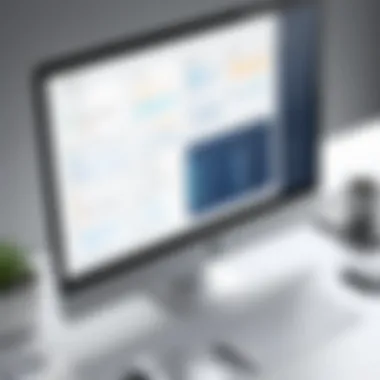Comprehensive Guide to Chiropractic Note Taking Software


Intro
In the realm of chiropractic care, efficient documentation and record-keeping are paramount. The integration of technology into this process has paved the way for specialized software that caters to the unique needs of practitioners. Chiropractic note taking software is designed to streamline patient information management, enhance practice efficiency, and support compliance with healthcare regulations. This guide will delve into essential features, benefits, and the considerations necessary for selecting appropriate software, ultimately aimed at supporting decision-makers in the chiropractic field.
Overview of Core Features
Chiropractic note taking software encompasses a variety of functionalities that can significantly impact a practitioner's daily operations. Understanding these core features is essential for optimizing practice management.
Description of Essential Functionalities
The software typically includes:
- Patient Documentation: Secure storage and easy retrieval of patient records, treatment plans, and progress notes are fundamental. This helps in maintaining continuity of care.
- Template Options: Pre-designed templates facilitate quicker note-taking during patient visits, minimizing time spent on administrative tasks.
- Scheduling and Reminders: Many software options offer integrated appointment scheduling, which helps manage patient flow and reduces no-shows through automated reminders.
- Billing Integration: This feature streamlines the billing process, simplifying insurance claims and payment processing for services rendered.
- Reporting Tools: Comprehensive reporting capabilities allow practitioners to analyze trends, track outcomes, and prepare for audits.
Comparison of Features Across Top Software Options
When considering different software solutions, it is vital to evaluate features based on individual practice needs. Software like ChiroTouch, TherapyNotes, and Kareo each offer distinct functionalities:
- ChiroTouch: Known for its extensive reporting features and robust billing capabilities.
- TherapyNotes: Offers strong documentation tools along with a user-friendly interface.
- Kareo: Integrates smoothly with practice management tools, ideal for small to medium-sized practices.
User Experience and Interface
The effectiveness of chiropractic note taking software often hinges on its user interface and overall user experience. A well-designed system can drastically improve the efficiency with which practitioners document patient care.
Insights into UI/UX Design Aspects
Key aspects of effective UI/UX design include:
- Intuitive Navigation: Software should feature a user-friendly layout that allows for easy access to various functionalities. Users should be able to locate tools quickly without unnecessary complexity.
- Customizability: Options for customizing note templates or dashboards to fit individual practitioner preferences enhance usability.
- Mobile Compatibility: Some software provides mobile access, allowing practitioners to document notes on-the-go, which can improve overall care delivery.
Importance of Usability and Accessibility
Usability is critically important. Software that prioritizes ease of use encourages consistent adoption within practices. Furthermore, ensuring accessibility for all staff members, including those who may not be tech-savvy, is crucial.
"The most effective software is one that enhances practice, making documentation seamless without being intrusive."
Understanding Chiropractic Note Taking Software
Chiropractic note taking software has become a fundamental tool for practitioners aiming to enhance their practice management. As the healthcare industry evolves, the necessity for efficient documentation methods that streamline workflows has never been more critical. Understanding this software is key, as it shapes how practitioners interact with patient care and record management. In this section, we will explore the definition, purpose, and key features of chiropractic note taking software to illuminate its relevance in modern practices.
Definition and Purpose
Chiropractic note taking software is designed specifically to assist chiropractors in managing patient information effectively. It provides a digital platform for documenting treatment plans, patient history, and clinical findings. The primary purpose of this software is to enhance the accuracy and efficiency of documentation, thereby improving overall patient care.
Such software often complies with industry standards, which is essential for legal and insurance purposes. It can integrate various functionalities that support practice operations, such as billing integration and scheduling, making it a multifaceted tool for practice management.
Key Features of Chiropractic Note Taking Software
Key features are what differentiate chiropractic note taking software from traditional methods. Understanding these features can help decision-makers choose the right tool for their practice.
Customizable Templates
Customizable templates allow practitioners to tailor the documentation process to their specific needs. This is significant because every practice may have unique requirements based on their patient demographics or treatment modalities.
The key characteristic of customizable templates is their flexibility. Users can create or modify forms that suit various treatment situations. This feature is beneficial as it improves consistency in documentation while saving time.
A unique aspect is that these templates often come pre-loaded with common terminology and fields relevant to chiropractic care. This can reduce the learning curve for new staff. However, there can be a disadvantage; if templates are not regularly updated, they may become obsolete or irrelevant.
Patient History Management
Patient history management is a pivotal function of chiropractic note taking software. Proper management of patient history allows practitioners to have all necessary information at their fingertips. This facilitates informed decision-making regarding treatment options.
One of the key characteristics of patient history management is its ability to track changes over time. This gives practitioners insight into a patient’s progress, allowing for better adjustments to treatment plans. This aspect is beneficial in establishing trust with patients as their history becomes more transparent.


On the contrary, a potential downside is the reliance on accurate entries. Errors in data input can lead to incorrect assessments, which may affect patient care. It is vital that practices maintain rigorous training and review protocols to prevent such issues.
Progress Tracking
Progress tracking in chiropractic note taking software serves to monitor a patient's improvement after treatment. This feature contributes significantly to the overall goal of enhancing patient outcomes by providing measurable data.
One key characteristic of progress tracking is its visual representation of changes. Graphs and charts can sometimes illustrate progression more effectively than written notes alone. This visual aid can also assist in patient education, helping them understand their recovery journey.
However, a notable disadvantage may occur if data is not entered consistently. Inconsistent tracking can produce misleading results, leading to ineffective treatment strategies. Thus, regular updates are crucial to maintaining the integrity of progress records.
Effective use of chiropractic note taking software relies heavily on understanding its features and proper training of its users.
Benefits of Using Chiropractic Note Taking Software
Chiropractic note taking software holds significant importance in modern practice management. This software provides a range of benefits that enhance workflow, improve patient care, and ensure documentation accuracy among many other advantages. For decision-makers in the chiropractic field, understanding these benefits is essential for making an informed software selection.
Enhanced Documentation Accuracy
One of the primary advantages of using chiropractic note taking software is its ability to improve documentation accuracy. Manual note-taking often leads to discrepancies, lost information, or misinterpretations. Software designed for this purpose typically includes customizable templates that allow practitioners to standardize their documentation process.
Furthermore, many software solutions offer features that prompt users for essential patient information and treatment details. This minimizes the risk of omitting vital data. The software can also validate entered data against established criteria, ensuring maintained accuracy. A minute error in documentation can have significant ramifications for patient care and legal compliance, so accuracy cannot be overstated.
Time Efficiency
Another important benefit is the time efficiency that these software solutions provide. Chiropractors can spend considerable time on administrative tasks, which detracts from patient care. Chiropractic note taking software automates many of these tasks such as appointment scheduling, billing, and invoicing. As a result, clinicians can devote more time to their patients.
In addition, many solutions come with built-in features that facilitate quick access to patient records. This reuse of templates can drastically reduce the time spent documenting each patient visit. For busy practices, this efficiency translates into the ability to increase patient turnover without sacrificing service quality.
Improved Patient Care
Improved patient care is a crucial benefit that arises from using chiropractic note taking software. With accurate and efficient documentation, practitioners can access patient histories and treatment plans swiftly. This aids in delivering tailored care to each patient, greatly enhancing the overall treatment experience. An integrated system often allows for tracking a patient’s progress over time, enabling clinicians to make informed decisions based on real-time data.
Furthermore, when the administrative burden is reduced, practitioners can spend more quality time with their patients. Effective communication and stronger practitioner-patient relationships tend to stem from this increased interaction. Building trust in the chiropractor's approach is vital for successful treatment outcomes.
By streamlining documentation and improving operational efficiency, chiropractic note taking software not only saves time but also fosters a more patient-centered environment.
In summary, the benefits of using chiropractic note taking software are numerous. Enhanced documentation accuracy, increased time efficiency, and improved patient care create a compelling case for adoption. As practices evolve, leveraging technology to optimize these facets will be paramount for success.
Factors to Consider When Choosing Software
Selecting the right chiropractic note taking software involves careful evaluation of various factors. The software not only helps in the documentation process but also impacts overall practice efficiency. Therefore, understanding the specific elements that comprise user experience, integration, compliance, and security will aid decision-makers in making an informed choice.
User Interface and Experience
A user-friendly interface is critical when choosing chiropractic note taking software. A clean and intuitive design minimizes the learning curve, allowing practitioners to focus more on patient care than on navigating complex features. The layout should facilitate easy access to frequently used functions and streamline the documentation process. A good user experience reduces errors in data entry and enhances productivity.
Integration with Other Systems
Integration capabilities are essential for maintaining a cohesive practice management ecosystem. Connecting chiropractic note taking software with existing systems such as Electronic Health Records (EHR) or billing software ensures seamless workflows.
EHR/EMR Systems
EHR/EMR systems are pivotal in modern healthcare environments. They allow for efficient storage and retrieval of patient information, which is essential for comprehensive care. The key characteristic of EHR systems lies in their ability to centralize patient records. This makes it a widely adopted solution. The unique feature of EHR systems is their interoperability; they can exchange data with other healthcare applications. However, managing data across multiple platforms may pose challenges such as communication gaps between systems.
Billing Software
Billing software is crucial for financial management in practice settings. The key benefit of billing software is its capacity to automate billing processes, reducing errors and improving revenue cycle management. A notable feature of such software is its ability to track claims and customer payments. A downside is that, if not properly integrated, it may lead to discrepancies in financial reporting. This can affect overall practice performance.
Compliance and Security
Compliance with regulatory standards is a requirement in the healthcare sector. Thorough understanding of compliance and security features in software options is required to ensure that patient data is protected.
HIPAA Compliance


HIPAA compliance provides guidelines for safeguarding patient information. This is crucial in operating any healthcare practice. The key aspect of HIPAA compliance is its rigidity in requiring that all collected health information is kept confidential. An appealing feature of software that adheres to HIPAA regulations is the assurance it provides to both practitioners and patients regarding data safety. However, the added compliance measures may necessitate additional training and resources for staff.
Data Encryption
Data encryption is an essential component to protect sensitive patient information from unauthorized access. The principle characteristic of data encryption is its capability to make information unreadable to anyone without the proper access credentials. This feature is beneficial for maintaining trust with patients regarding the confidentiality of their health data. Nonetheless, reliance on encryption requires robust IT support to manage encryption keys and ensure that the software remains updated to address threats.
Leading Chiropractic Note Taking Software Options
The selection of the right chiropractic note-taking software can greatly influence the efficiency and effectiveness of a practice. Choosing the right solution involves understanding various elements such as features, pricing, user feedback, and the support offered by the vendor. It is not just about having a software tool; it is about integrating that tool into daily practice in a way that enhances workflow, documentation, and patient interaction.
Comparison of Top Solutions
Features Overview
Features overview provides insights into functionalities that chiropractic note-taking software may offer. Common features include customizable templates, which facilitate tailored documentation for each patient. This can make the process more efficient. Tools that allow for easy access to patient history management can streamline patient consultations, improving the quality of care. Furthermore, effective progress tracking features inform both the practitioner and the patient about treatment outcomes.
One beneficial aspect is how these features save time and improve accuracy. Software that integrates these tools within an intuitive dashboard allows practitioners to easily navigate tasks. However, not all features may be necessary for every practice, which may lead to confusion or over-complication.
Pricing Structures
Pricing structures of chiropractic note-taking software vary significantly. Some platforms charge a one-time fee, while others offer subscription-based pricing. An important characteristic is the scalability of pricing plans. This enables practices, regardless of size, to find an affordable option that fits their specific needs.
The distinct feature of subscription pricing is that it can sometimes include updates and support, which can minimize additional costs later. On the other hand, one-time fees may seem appealing initially, but can lead to higher expenditures when upgrade costs arise.
User Feedback
User feedback serves as a substantial resource for evaluating chiropractic note-taking software. Reviews from other practitioners provide real-life insights into the advantages and disadvantages of specific solutions. A significant aspect of user feedback is the shared experiences regarding ease of use. Many users appreciate software that requires minimal training time, which drastically influences productivity.
Another common feedback point is regarding the responsiveness of customer support. Responsive support enhances the user experience, especially when issues arise. However, not all software vendors provide comprehensive support. Poor ratings in support can indicate potential challenges once a software is in use.
Vendor Reputation and Support
Vendor reputation and support play critical roles in selecting a chiropractic note-taking software. A software company with a solid reputation often indicates reliability and quality. Positive industry presence suggests that the software complies with standards and meets user needs effectively.
In addition, ongoing support from the vendor ensures that practitioners can resolve any issues and maintain their practice’s operational flow. This support may include troubleshooting assistance, software updates, and regular check-ins. However, it is important to read reviews thoroughly to gauge the actual support quality from individual vendors. Long-term relationships with reputable vendors usually lead to more successful software implementations.
Implementation Strategies for Effective Use
Incorporating chiropractic note taking software into a practice requires careful planning and execution. The implementation process directly influences how well the software will serve the practice's needs. Effective strategies ensure that the benefits of the software are fully realized. This section outlines key elements of successful implementation, emphasizing training, transitioning from traditional methods, and ongoing evaluation.
Training and Onboarding
Effective training is vital for engaging all users with the new software. Staff must understand how to use the features adequately. This process begins with onboarding sessions that outline the software's functionality and best practices. Including both in-person and online tutorials can cater to different learning preferences. Moreover, ongoing support and resources should be readily available.
- Key aspects of training include:
- Hands-on practice sessions.
- Access to comprehensive user manuals.
- Regular Q&A sessions for troubleshooting.
Creating a culture of continuous learning around the software helps in adapting over time. Leaders should encourage feedback from users to refine training approaches.
Transitioning from Paper to Digital
Moving from a paper-based system to a digital format can pose challenges. It is crucial to approach this transition systematically to minimize disruptions. The migration process should include data backup methods to prevent loss. Once transferred, it is essential to familiarize users with how to effectively navigate and input data into the software.
- Considerations during this phase:
- Mapping out existing processes and identifying areas for improvement.
- Ensuring all staff are aware of timelines and expected outcomes.
A phased approach can facilitate smoother transitions. Implementing the software in stages allows for real-time feedback and adjustments.
Monitoring Usage and Effectiveness
After implementation, monitoring how the software is utilized is important. Regular assessments can reveal insights into user engagement and software effectiveness. Metrics such as time spent on documentation, patient interaction frequency, and error rates can provide valuable data.


- Steps to monitor include:
- Setting specific KPIs to evaluate success.
- Conducting periodic reviews with staff to gather insights and suggestions.
Feedback loops should be established. This ensures that users feel heard and that their experiences inform future updates or training sessions. Regular monitoring not only promotes effective use but also emphasizes the commitment to improving practice management.
"Effective implementation goes beyond software capabilities; it is about creating a framework for users to thrive."
Creating an environment that embraces technology allows practices to focus more on patient care. By adopting these strategies, decision-makers will find their operations becoming not just efficient but also more responsive to patient needs.
Impact of Chiropractic Note Taking Software on Practice Management
Chiropractic note taking software significantly influences the overall practice management of chiropractic clinics. By integrating various functionalities that foster efficiency, this software is not merely a tool for documentation but a strategic component in enhancing the operational framework of a practice. Efficient recording and retrieval of patient data streamline many processes that can otherwise burden a practitioner and staff. Improved documentation leads to better patient outcomes and fewer administrative errors, ultimately elevating the quality of care delivered.
Streamlined Workflow
One of the primary impacts of chiropractic note taking software is the streamlined workflow it creates. Traditional paper-based methods often involve unnecessary delays and complications in documenting patient visits. Software solutions provide customizable templates that allow practitioners to easily record relevant patient information during or immediately after sessions.
As practitioners might know, a well-organized note taking system reduces the friction of manual input. Staff can quickly access patient records, reducing the time spent searching through files or organizing paperwork. Additionally, automation of routine tasks plays a vital role here. When reminders and follow-ups are managed through the software, the entire team can stay aligned on patient care plans and scheduling. This functionality enables a more cohesive operation where everyone contributes to a shared goal of patient well-being.
"The efficiency gained through software leads not only to productivity but also to enhanced patient trust."
Client Satisfaction and Retention
Client satisfaction is directly impacted by how efficiently a practice operates. When chiropractors use note taking software to manage patient interactions and records, the overall experience for patients improves significantly. Clients tend to appreciate timely communication and access to their records or treatment plans, which can foster a sense of reliability and professionalism.
Furthermore, the accuracy and accessibility of records mean that patients receive personalized and coherent care. When their health history is properly recorded and readily available, practitioners can make informed decisions that reflect the patient's journey. This attention to detail positively influences patient retention rates, as satisfied patients are likely to return for future services.
In summary, the impact of chiropractic note taking software on practice management cannot be overstated. With improved workflow and client satisfaction, chiropractic offices can not only survive but thrive in a highly competitive environment.
Future Trends in Chiropractic Note Taking Software
In a rapidly evolving digital landscape, the trends shaping chiropractic note taking software are of paramount importance. These trends reflect the technology advancements and changing needs of practitioners and their patients. Understanding these trends not only helps practitioners stay ahead but also ensures that their practices remain effective and efficient.
Emerging Technologies and Innovations
The integration of emerging technologies in chiropractic note taking software is enhancing functionality and user experience. Several key innovations are becoming more prevalent in the market:
- Cloud Computing: Cloud-based solutions offer flexibility and accessibility, allowing practitioners to access patient records and documentation from anywhere with an internet connection.
- Mobile Applications: Increasingly, practitioners are using mobile apps to manage patient records. These applications streamline the documentation process during sessions, minimizing delays and increasing efficiency.
- Telehealth Features: With the rise of remote consultations, software that includes video conferencing and e-consultations tools is gaining traction. This not only expands service offerings but also improves patient engagement.
Adopting these emerging techs can significantly enhance practice management and improve patient interaction. Practitioners who invest in these innovations may find themselves with a competitive advantage.
The Role of Artificial Intelligence
Artificial Intelligence (AI) is steadily becoming a cornerstone in the functionality of chiropractic note taking software. This technology enhances operational efficiency and accuracy in several ways:
- Automated Documentation: AI can aid in automating record-keeping processes. This not only reduces the time required for documentation but also minimizes the risk of human error.
- Predictive Analytics: Tools that utilize AI can analyze patient data to identify patterns. This enables practitioners to make informed decisions regarding treatment plans, improving patient outcomes.
- Personalized Care: AI-powered systems can recommend personalized treatment options based on historical patient data, preferences, and outcomes. This level of tailored care is invaluable in today’s health landscape.
As AI technologies continue to evolve, their implementation in chiropractic practices could reshape documentation and patient management.
"The adoption of sophisticated technology such as AI can lead to more efficient practices and ultimately better patient care."
By embracing these future trends, chiropractic practices can ensure they remain not only relevant but also conducive to patient-centered care. Understanding these trends is crucial, as they outline the path toward improved efficiency and patient satisfaction.
Epilogue
In closing, the discussion surrounding chiropractic note taking software underscores its pivotal role in enhancing the operations of chiropractic practices. This software not only streamlines documentation processes, but also fosters greater accuracy and efficiency in managing patient information. The significance of choosing the right software cannot be overstated, especially when considering compliance requirements and integration possibilities.
Key takeaways from this article highlight the necessity of understanding individual practice needs before making a decision. Chiropractors must evaluate their current systems and identify gaps that software could address. Moreover, effective implementation strategies are essential to ensure that staff feel comfortable navigating new tools.
As technology continues to evolve, embracing chiropractic note taking software becomes integral to maintaining high standards of patient care and optimizing practice management. The benefits are manifold, including improved client retention, enhanced workflow, and ultimately better health outcomes for patients.
Summary of Key Takeaways
- Chiropractic note taking software significantly improves documentation accuracy and efficiency.
- Key features include customizable templates and patient history management.
- Practitioners should prioritize user experience and software integrations during selection.
- Ongoing support and training are crucial for successful implementation.
- Future advancements in technology, especially artificial intelligence, may further transform how practices operate.
"Investing in chiropractic note taking software represents a commitment to excellence in patient care and operational efficiency."
In summary, for chiropractic practices, leveraging appropriate software is an essential step toward progressive management and optimal patient satisfaction.



